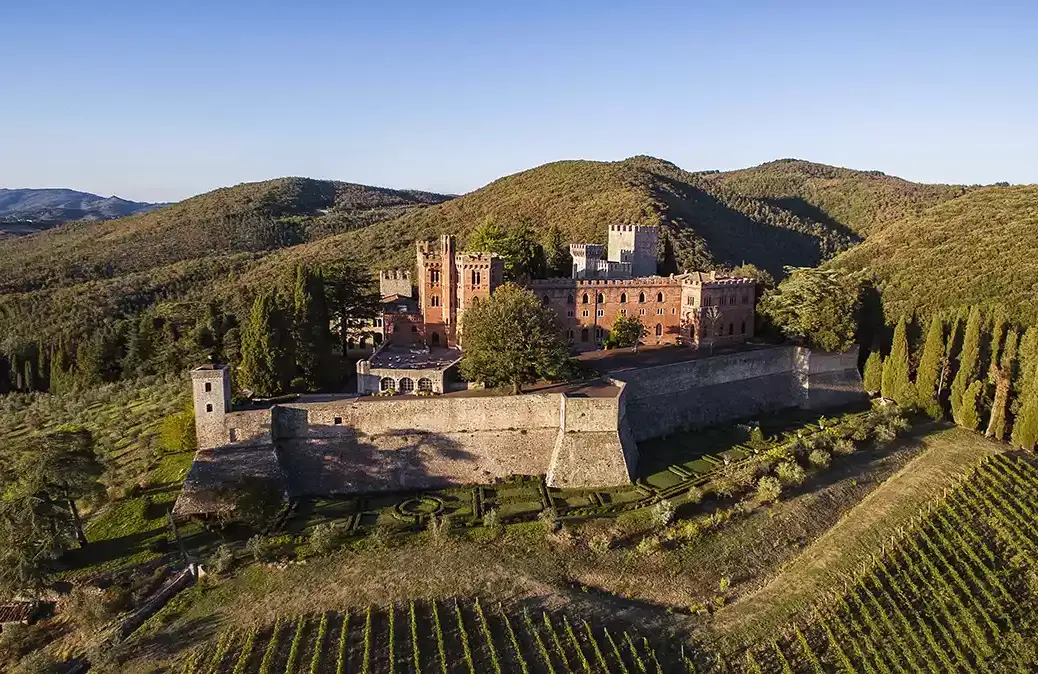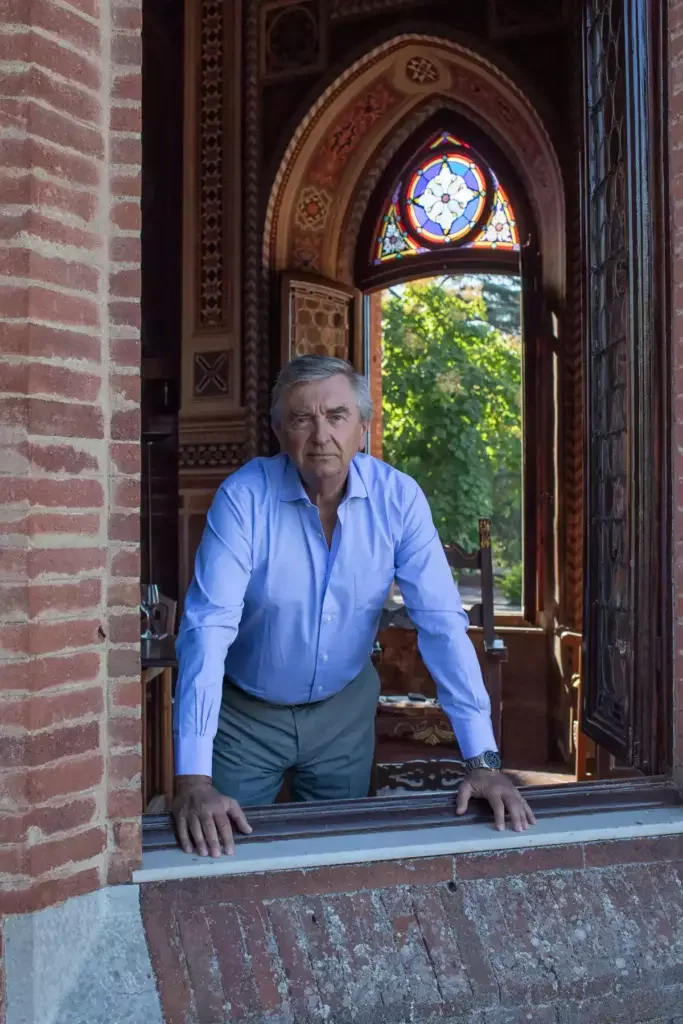
Joanna Simon joins Francesco Ricasoli for the launch of the latest vintages from Castello di Brolio, including a surprising new Trebbiano.
Apart from sounding somewhat oxymoronic, a tasting lunch at Dinner by Heston is almost guaranteed to be of interest. It’s all the more so when the wines are from a producer of the stature of Castello di Brolio, Chianti Classico’s grandest, largest, and most historic estate, and yet more so when the wines are being presented by Francesco Ricasoli, the man who has guided and presided over them for three decades and whose very affability belies the single-mindedness he has shown since buying back the debilitated family company (giving up a glamorous photographic career to do so).
The wines to be tasted, described as the culmination of his 30 years at the helm, centered on the newly released 2020 vintage of each of the four Chianti Classico Gran Selezione—the flagship Castello di Brolio and the three single-vineyard crus: Colledilà, Roncicone, and CeniPrimo. All four are pure Sangiovese. We also tasted the 2019 Casalferro (Merlot), 2021 Torricella Chardonnay (crisp, precise, fine-boned, discreetly oaked), and, not least, 2020 Castello di Brolio Sanbarnaba, a new white wine that the invitation disclosed, eye-catchingly, is made from 100% Trebbiano. And that is not a variety one associates readily with quality or interest or, indeed, with Francesco’s characterization of the Ricasoli wine style as “balance, elegance, length, purity, and typicity.”
If the grape variety seemed a surprising choice, it was nothing to the wine itself. Pale yellow-orange in color, it had been vinified on its skins with selected yeasts for three months in 900-liter cocciopesto terra-cotta amphorae at 57°F (14°C), then aged for 12 months in a combination of amphorae (40%), stainless steel (30%), and two- and three-year-old barriques (30%). It was bottled in December 2021.
The inevitable question was, Surely this is an orange wine, not a white? “You will never see an orange wine from Ricasoli,” Francesco Ricasoli answered, without missing a beat. It is not an orange wine, he says, because it’s not an oxidative style. Cocciopesto, a material used by the Romans for aqueducts, has exceptionally low porosity, resulting in the merest microoxygenation and in slow maturation. (I wrote in more detail about cocciopesto in WFW 77, reviewing Tenuta Ghizzano’s Mimesi Sangiovese.)
Another inevitable question: Why Trebbiano? “A challenge,” was the short answer. But the challenge itself was a long one. Over about ten years, the team tried all sorts of things—indigenous and non-indigenous white varieties, fancy vinifications… “To be honest, I was a bit fed up,” Francesco admits. Not least because for years he wasn’t a believer in Trebbiano and wasn’t sure about releasing one, but by last year he felt that they had got it right, with the amphorae-fermented, skin-contact 2020, a wine that he says “relies very much on the Ricasoli style” and has the potential to improve in bottle.
Ricasoli and research, terroir, and sustainability
The 1.18ha (3-acre) Sanbarnaba vineyard, on sandstone soils (macigno del Chianti) at an altitude of 1,540–1,575ft (470–480m), was planted in 2003 with Merlot and grafted over to Trebbiano in 2018, with a selection of historic clones found on the property when massal selections of Sangiovese were being carried out (more on which below). Just 5,600 bottles were produced, and the wine is priced on a par with Castello di Brolio.
Given its prolonged gestation and that it stands alongside, and bears the name of, Castello di Brolio, the launch of Sanbarnaba last September was clearly a milestone, but it doesn’t change either the focus of the estate, which remains Sangiovese, or the wine-growing philosophy, the three central tenets of which are research, terroir, and sustainability—social as well as environmental sustainability under Equalitas certification.
Currently, the vineyards that Francesco planted in the 1990s—when he “changed everything”—are being replanted. The program includes grubbing up some of the international varieties and replacing them with Brolio’s own clones of Sangiovese. These were painstakingly selected once the entire 240ha (600 acres) of vineyards, one fifth of the 1,200ha (2,965-acre) Gaiole estate, had been mapped out (or zoned) by Ricasoli’s technical team, in conjunction with, from 2005, the CRA (Council for Agricultural Research).
The research identified 19 soil types across five main groups. Based on these, the Ricasoli team did more than 200 single-parcel vinifications. Francesco believes that this was the first time in the history of Chianti Classico that pure Sangiovese was made in exactly the same way from different soils and parcels. Ultimately, it led to the creation of the three single-vineyard Gran Selezione and to Castello di Brolio becoming 100% Sangiovese in 2018. Other varieties, which had once included the Cabernet Sauvignon planted by Francesco, were dropped—deemed unnecessary now for the international market and, above all, for the quality and style of the wine. Brolio’s Sangiovese alone was enough.
In a nutshell, although the 2020 growing season was notable for its almost total lack of rain and record summer heat, grape quality was excellent, largely thanks to cool nights in September and October. All four Chianti Classico offerings are 100% Sangiovese and aged for 22 months in 500-liter tonneaux, 30% new and 70% second fill.

Tasting
2020 Castello di Brolio Sanbarnaba IGT Toscana
100% Trebbiano vinified on skins in amphorae for three months. Aged for 12 months in amphorae (40%), stainless steel, and barriques (not new).
Pale yellow-orange. Appetizingly fresh but initially restrained on the nose, with a delicate fragrance of dried flowers, citrus, especially orange, and a whiff of green cardamom. With time in the glass and, more important, as the temperature rises, the nose opens out, gaining a degree of creaminess and a slight nuttiness, which are echoed on the palate. In the mouth, it’s immediately fresh, dry, and clean-lined, with a seam of apple succulence, but it’s also ample, quite powerful, deeply textural, rich, and silky. In apparent contradiction, it moves with almost weightless elegance to a long, softly saline, very lightly chewy finish. If this is contradiction, I like it. The wine should not be served chilled like a white wine. Francesco Ricasoli recommends 54–55.5°F (12–13°C). I would say don’t be afraid to go to 57°F (14°C). | 92
2020 Ricasoli Colledilà Chianti Classico Gran Selezione Gaiole
Single-vineyard, 100% Sangiovese, alberese soils (clayey limestone), planted in 2002. First produced in 2007. Made in larger quantities than the other two single-vineyard wines.
Deep ruby-purple, with spicy, floral and lifted black fruit aromas. The fruit—black berries joined by cherries on the palate—blends crunchy freshness and sweetness with mellifluous purity. Luminous and expressive, with touches of orange pomander, seamlessly woven with pliant tannins. Lovely already, but it has the structure to last well into the mid-2030s. | 94
2020 Ricasoli Roncicone Chianti Classico Gran Selezione Gaiole
Single-vineyard, 100% Sangiovese, Pliocene marine deposits, planted 1998–2000. First vintage: 2015.
Slightly paler than the Colledilà and a little more closed and less approachable. Darker, slightly chunkier fruit and a more savory character, with smoky and mineral notes and fine-grained tannins. Tightly sprung and less immediately welcoming than the Colledilà, but the way it unfurls and relaxes in the glass is a sign of things to come. | 94
2020 Ricasoli CeniPrimo Chianti Classico Gran Selezione Gaiole
Single vineyard in the southernmost part of the estate, 100% Sangiovese, complex silty soils on an ancient river terrace, planted in 1998. First vintage: 2015.
The richest and most intense of the single-vineyard Sangioveses, but fine-boned and graceful (with the lowest pH—3.18—of these low-pH red wines). Perfumed and mineral, with aromas of violets, sweet red cherries, red berries, and fresh orange overlaying a delicately smoldering, balsamic note. Mouth-filling red-berry and blackberry fruit, braced with ripe but firm tannins and keen, well-integrated acidity. Complex, long, and only just beginning to unpack its many tissue-fine layers. | 95
2020 Castello di Brolio Chianti Classico Gran Selezione Gaiole
From three soils—sandstone (macigno), schist-based galestro, and alberese—lying at 1,300–1,600ft (400–490m); higher altitude than the single-vineyard Sangioveses, at 1,000–1,250ft (300–380m).
Deep ruby-purple. Fragrant with red berries, sandalwood, incense, orange blossom, and a hint of orange zest. A flowing, elegantly concentrated palate, with a velvet embrace, sweet-fruit intensity, cedar, sandalwood, and a gentle rustle of hazelnut chocolate, all carried by chalk-dust tannins and immaculate, pin-fine acidity. | 95
2019 Casalferro IGT Toscana
100% Merlot from three vineyards (two at 1,300ft [400m], one at 1,650ft [500m]) and two soils, limestone (alberese) and sandstone (macigno). Aged for 21 months in tonneaux and barriques, 30% new and 70% second and third fill. The first all-Merlot vintage was 2007.
The second vintage in a new style that Francesco Ricasoli calls his “Chiantified Merlot.” Deep purple color. A core of concentrated, ripe, but notably fresh fruit, fringed by spice, licorice, graphite, and cocoa aromas. With red cherry in the ascendancy over black cherry and plum, sleek tannins, and lithe, energy-giving acidity, this is a sophisticated, distinctive Merlot—a far cry from jammy, chocolate-rich, international styles. | 94






